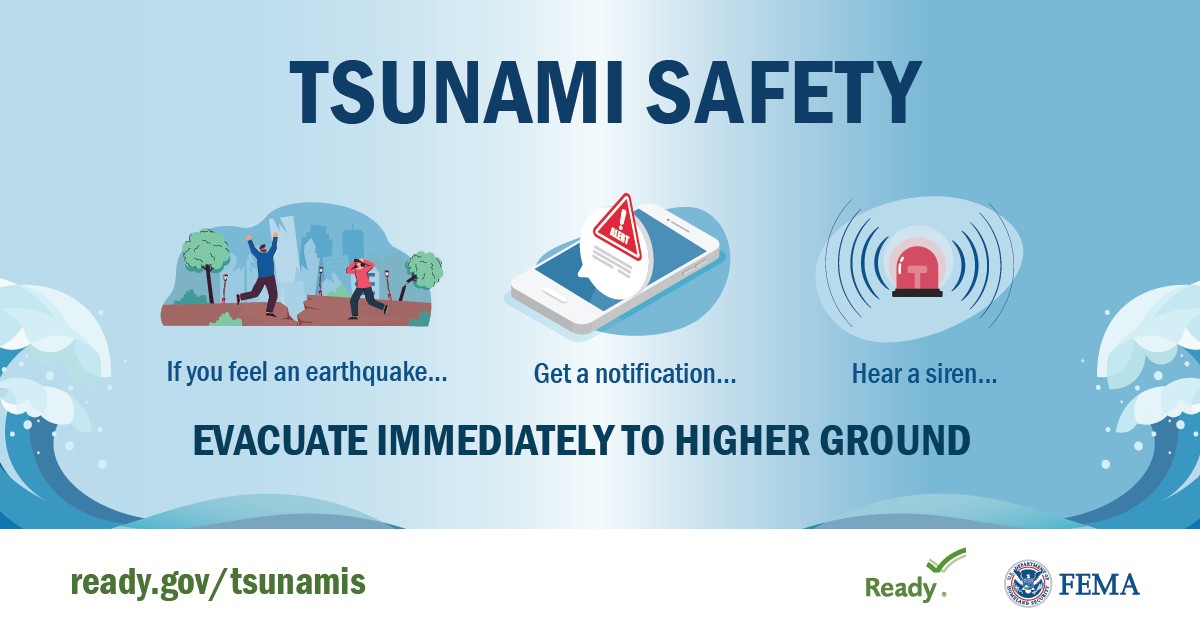On July 29, an 8.8 magnitude earthquake triggered Pacific-wide tsunami alerts. These alerts were a good reminder of how important it is to be prepared. A tsunami can cause flooding as well as disrupt transportation, power and water supply.
Whether you live on the coast, or plan to travel anywhere along coasts, knowing about tsunami alerts, warning signs and evacuation routes, can help you stay safe.
Here are five ways to be tsunami ready.
Learn the Signs of a Potential Tsunami

There are several signs that could indicate the potential for a tsunami. This includes:
- An earthquake.
- Unusual ocean behavior, such as a sudden rise or wall of water or sudden draining of water from beaches, showing the ocean floor.
- A loud roar from the ocean.
Know the Difference Between the Alerts
A good way to prepare for a threat like tsunamis is to sign up for your community’s warning system. You can visit Ready.gov to find the best type of alert systems to sign up for.
There are multiple types of alerts that may occur during a potential tsunami threat. Knowing the difference between each will help you respond quickly.
Tsunami Information Statement
- What it means: An Earthquake was detected, but no tsunami threat or a minor tsunami expected.
- How to respond: No immediate action required. Stay informed.
Tsunami Watch
- What it means: A potential tsunami generated by a significant earthquake.
- How to respond: Stay informed. Prepare for possible evacuation.
Tsunami Advisory
- What it means: a tsunami capable of producing strong currents or waves dangerous to those in or near the water.
- How to respond: Stay out of the water and away from beaches and waterways.
Tsunami Warning
- What it means: A dangerous tsunami about to happen or already occurring.
- How to respond: Evacuate: DO NOT wait! Leave as soon as you see any natural signs of a tsunami or receive an official tsunami warning.
Know how to respond
If you feel an earthquake:
If there is an earthquake and you are in a tsunami area, protect yourself from the earthquake first. “Drop, Cover, and Hold On.”
- Drop to your hands and knees.
- Cover your head and neck with your arms.
- Hold on to any sturdy furniture until the shaking stops.
Crawl only if you can reach a better cover, but do not go through an area with more debris. When the ground stops shaking, move to higher ground.
If you get a tsunami alert:
Follow the guidance you receive in the alert. Remember: the guidance may be different depending on the type of alert you receive.
If you hear a siren:
Leave immediately and get to higher ground if you are told to do so.
If you’re in the water when a tsunami is approaching:
If you are in the water, grab onto something that floats, such as a raft or tree trunk. If you are in a boat, face the direction of the waves and head out to sea. If you are in a harbor, go inland.
Know Your Evacuation Routes
It’s important to know and practice your community evacuation routes ahead of time. Some at-risk communities have maps showing evacuation zones and routes. Evacuation route signs often feature a wave with an arrow indicating direction to higher ground.
Traffic can cause delays during evacuation, so know multiple routes you can take. You should also consider evacuating on foot when possible.
Be sure to map out your routes from home, work and play. Pick shelters high above sea level, or at least a mile inland.
It’s a good idea to create a communication plan with your family that includes where to meet if you get separated and lists a contact who doesn’t live in the area.
Be Ready to Go
You may have to evacuate at a moment’s notice, so it’s always a good idea to be ready. Put together an emergency kit for your home, work and car.
Some things to include:
- Food and water for each family member.
- Flashlights.
- First-aid kit.
- Clothes and blankets.
- Medications.
- Radio.
- Batteries.
- Pet food (if necessary).
- A whistle to signal for help.
- Sleeping bag(s) or blankets.
For more information about preparing for a tsunami, visit Ready.gov.

